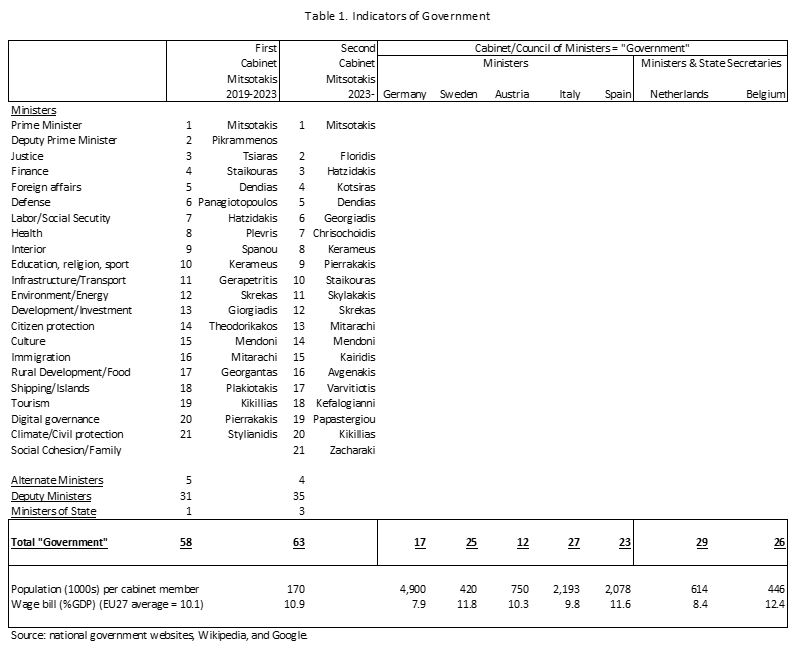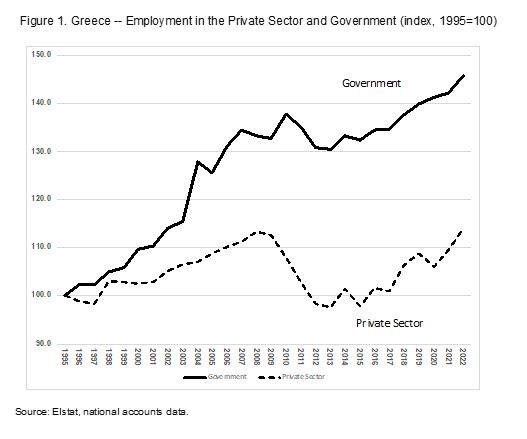-
 Podcast - Tax cuts and balancing acts: Greece's 2026 budget
Podcast - Tax cuts and balancing acts: Greece's 2026 budget
-
 Podcast - Main character energy: Greece vies for leading fossil fuel role
Podcast - Main character energy: Greece vies for leading fossil fuel role
-
 15% Uncertainty: Greece, Europe and the tariff shockwave
15% Uncertainty: Greece, Europe and the tariff shockwave
-
 Summit of transactions – Erdogan and Trump
Summit of transactions – Erdogan and Trump
-
 Podcast - DETH and taxes: The only things certain in Greek politics
Podcast - DETH and taxes: The only things certain in Greek politics
-
 How will Trump's tariffs affect Greece?
How will Trump's tariffs affect Greece?
Where are the Conservatives?

Kyriakos Mitsotakis won an impressive election victory in June 2023 to lead Greece for a second term as Prime Minister. He heads the New Democracy party (ND). Mitsotakis and ND profile themselves as “conservatives.” The main opposition parties, SYRIZA and PASOK, may be seen as “further left” (progressive) and “center left” (labor party), respectively.
It is, in fact, not so easy to describe political movements by a single word, as though we can put a sticker on the forehead of their supporters and leaders, because parties sometimes make policy decisions that do not fit easily with the emotional impressions of summary labels. Indeed, it is important that we respect that political leaders sometimes make decisions/need to make decisions, that don’t fit easily within a narrow framework of political allegiance. A politics oriented around individual issues, topics, and areas of analysis, always oriented toward ascertaining what is in the best interest of the public good, seems preferable than one based on an ideological projection of being perceived as left, center-left, center-right, or right.
That facts and numbers are more important and relevant than marketing campaigns and political rhetoric may perhaps be best underscored by the impression that the quick labels we apply to political parties and their leaders have actually become very confusing. I even suspect that this confusion is on purpose. Politicians sometimes want us, the voters, to believe that they are in a certain way (the quick sticker), but, in practice, they are not at all in that way.
I would love to find a political party that I could consider “financially (very) conservative, but socially (very) liberal.” The “financial conservative” part would imply a small government, strong market signals (clean prices, few subsidies, moderate tax rates with very broad bases, strong anti-trust provisions, strong transparency and disclosures), and, especially, small deficits or a balanced budget and low debt (if we want something, we must be willing to pay for it). In this world, I would advise against placing the costs of the pleasures of our existence on a credit card that we then bestow on our children. The “socially liberal” part is best captured by the word: tolerance. Different people have legitimate differences in preferences, and this difference should be respected. We are too small and puny, and have too many shortcomings, to be the judge of someone else’s sexual orientation, gender perception, sense of satisfaction in their own existence, color of their skin, or cultural affinity. As long as these differences do not become an impediment to anyone’s personal development, we should tolerate all of them, without feeling any political pressure to sign up for one preference over another.
Above is a tentative definition, and perception, of the word “conservative.” You may not agree. There may be better descriptors. But I hazard a guess that many people have a broad idea of what I mean. In this context, I believe that conservatives no longer exist; or, at least, they are going extinct. What we have instead is a fusion of political streams that all have one thing in common: populism. All are populists now. In Greece, you can be a populist on the right, which means ideologically that you favor tax cuts; or a populist on the left, which means that you are ideologically in favor of expanding government benefits/expenditures. None worry about deficits and debt. These are merely constraints to be ignored as long as possible. If you can get somebody else to pay for your deficits and debt, even better. And the children love their parents no matter what, even though teens from high school onward are starting to perceive that not all is as well as we like them to pretend it is (the eternal growth fantasy).
Mitsotakis and ND are proud conservatives. What do the numbers tell us about this notion in comparison with the political rhetoric? I tripped over this question when I read in the Greek media that the new cabinet had just been inaugurated—all 63 of them (63!). Honestly, I had never heard of a government where the cabinet level comprised 63 individuals. How does the PM conduct a meeting with so many persons around one table?
When facing a conundrum, it is helpful to do comparative analysis. We use data in other European governments that define the “cabinet” (or “council of minister” as they are often called) and how many individuals comprise this highest body of government (only members with “cabinet authority”). A sample is presented in Table 1. This is not a scientific study, which would require a public finance analysis, a political analysis, and a legal analysis (countries are organized differently), but the broad outlines are nevertheless instructive.
1. The first Mitsotakis cabinet measured 58 members. Thus, not only in contrast to declarations that conservatives favor small government, the cabinet grew further by 9 percent in persons from M1 to M2 (Mitsotakis 1 and 2).
2. The average number of “cabinet” members, sometimes including state secretaries, in the EU sample is 22 members.[1] This means that Greece has a cabinet that is 3 times larger than the average comparator country, and it is getting bigger.
3. Some countries have larger populations than Greece, which could give economies of scale. So, we can calculate how many citizens are served by each average cabinet member. In Greece, each official cabinet member serves, on average, 170,000 Greeks. In Germany, this is 4.9 million Germans per cabinet member; the closest comparator is Sweden at 420,000. Putting this the other way around, it implies that Greek cabinet members are very unproductive. It takes a big number of them to service the public. Conservative governments like to think of themselves as business people who know how to run the shop. This suggests otherwise.

4. We can compare the wage bill as a percentage of GDP across countries, because Eurostat presents these numbers. Greece, in 2022, had a wage bill of 10.9 percent of GDP. The EU27 average is 10.1 percent. Germany and the Netherlands mark the lower margins at 8-9 percent of GDP; Sweden and Spain mark the higher countries at over 11 percent. So, in the wage bill number, Greece sits in the middle of the pack, slightly above average.
5. There is the sense that Greece employs very many people in the public sector, but it has an average wage bill. This dilutes the gruel. Are there too many public employees who get paid too little per person, so that productivity and the quality of services to the public suffer? This accords with a refrain that the Greek public emits in surveys—"we don’t want to pay taxes because the services are so bad.” Tax probity thereby becomes an endogenous variable.
6. We can also look at the number of people working in government. This counts the evolution of general government employment over time in Greece. Elstat has a table, on a national accounts basis, that divides the entire economy in 10 industry groups. Nine of these groups, such as agriculture, industry, banks, tourism, etc. are private sector. One group is “government” to include public administration, defense, compulsory social security, education and health services provided by the public sector.
Figure 1 shows the index of employment in government and the private sector from 1995 onward. We can see that employment in government grows much faster than in the private sector. If Greece wants to boost productivity and per-capita income, this is the wrong allocation of labor resources.

In 1995, the government measured 737,000 total employment; in 2022 it was 1.1 million.[2] We can overlap over this interval what time periods particular governments were in office and see what happened to employment while they were in office. This analysis shows that Kostas Karamanlis (ND) wins the prize with an average increase in government employees while he was in office of 21,101 new workers per year. Number two is Kyriakos Mitsotakis (ND) who in his first term just ended with 15,413 new workers per year. Number three is Kostas Simitis (PASOK) with 14,265 new workers per year. George Papandreou (PASOK) and Alexis Tsipras (SYRIZA) each averaged about 8,000 a year, and only Antonis Samaras (ND) in the heat of the deep recession and subject to conditionality from the Troika saw the employment totals decline while he was in office.
It is stunning to find that conservatives consistently hire more people in government than any other political party. But all hire more people in government. This is not stunning, because the size of government determines power, and political parties are in the business of managing power. The more they have, the better it is for them. But this is not conservative or progressive; it is populist. The voters can choose between populists that want to cut taxes, or populists that want to expand benefits/expenditures.
Where have the conservatives gone?
Bob Traa is the author of books on the macroeconomy of Greece, Ecuador, The Netherlands, the United States, and the EU27, available from Amazon.com.
[1] Most of the comparators have coalition governments, which often implies the need for more jobs. Greece is a single party government (!), and vigorously so. This should have facilitated keeping jobs to a minimum.
[2] The compound growth rate of government employment is 1.4 percent. Real GDP grew by 0.9 percent. Thus, government employment has grown by 50 percent faster than real GDP; negative productivity per employee.